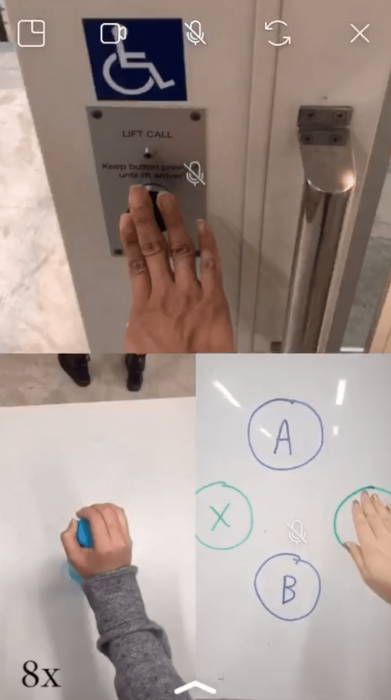
Write a description of the work, where it was performed, its objectives and outcome, and your overall experience of the work.
For this piece, we wanted to explore the mechanics of using technology to exert control remotely.
Inspired by the project Telegarden, as well as due to time constraints, we devised a scenario that allows two people to control what is happening on a third screen via the familiar mechanism of a game controller. Enqi and Amanda each took separate control of my movements and actions, by observing my point of view via a group chat on Instagram. It was perfect as I can easily see their instructions as well as they mine. In a way, there is a sense of transposing of the digital to analog here. By that I meant the input was analog at the start, then ‘converted’ into digital signals as a live chat stream, transferred to my end, where my brain interpreted the visuals and ‘instructed’ my limbs and hands to react accordingly. In a surreal sense, this experiment can be deemed slightly more advanced in mechanical terms than Telegarden as software’s visual interpretation capabilities have not caught up with its creator’s for the time being. That could also be the probable reason that such applications are still limited in scope.
Another fascinating aspect was even though the interactions between us were near real-time, there was still inevitably a slight delay, so my response trailed behind their instructions occasionally. This shortcoming is partially compensated by anticipation and prediction by all parties. Such is the case when dealing with remote real-time systems.
Lastly, during the brief journey around the ADM campus, I encountered a strange sight of several students being wheeled around on several push carts. This amusing encounter was directly observed by my comrades as well. Similar in nature to Telegarden, participants are transported, via the Internet, to another location while experiencing its sights and sounds. Technology has enabled us to widen our experiential possibilities even to places that are outside our reach. This seemingly simplistic and limited form of setup does not seem to decrease the immediacy as compared to an in-person experience. Projects like this and Telegarden allow its participants to observe, act or experiment from a safe and familiar place.
Of all the 3 Micro-Projects,
Which project did you feel you had the most creative control? Why?
I felt that it was the second project that allowed for the most creative control. In essence, the work had predefined parameters that are set by the artist, which closely shapes how the process unfolds and in which direction the end result is steered towards. The main objective was to collect opinions of a given question, and the expected end result isn’t exacting. Although one could also argue that the first piece is similar in nature, I think the key difference is the first piece had comparatively loosely defined parameters that allowed for more spontaneity and individual expression. Even though the second piece called for participants to express their opinions in a multitude of ways, this flexibility is being expressive in visual terms and not so much of expression of ideas or creative thought. Essentially, my group was in control of the key idea, and the participants are merely acting as highly chaotic inputs in generating variation.
Which project had the most unpredictable outcome? Why?
The first project called for each artist to make individual contributions, with the end result aggregated and thereby unpredictable. As the input is highly individualistic and involves a sizeable number of participants, I feel that its safe to say that the unpredictability factor increases in tandem. There is also no fixed objective per se for the piece. It is designed to be conversational and reflective, and by perusing the participants’ observations, we can get a sense of how every individual’s takeaway differed.
Which project best illustrates the concepts of DIWO & Open–Source? Why?
I feel the second piece best illustrates DIWO and open source as it utilises participation and the contribution of ideas(abstract, literal, visual and many other forms). In the open source movement, a key aspect is the collective contributions of many individuals that make up a piece of work, be it software, hardware, art, music etc. There are also opportunities for remixing, which is also an open source ingredient, should the participants choose to do so, in the second piece. Technically, participants can cut and paste each other’s content and modify as they see fit. The second project closely resembles any one of the millions of projects found on Github, where any user can contribute improvements. The spirit is also largely community-driven and self-less in nature; for the greater good. Interestingly, the end result is an assemblage of probable definitions of ‘what a designer is’, presenting a bewildering range of attitudes and aesthetic sensibilities all at once. Open source projects like these are great because they are backed by passionate contributors from all corners of the world.